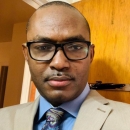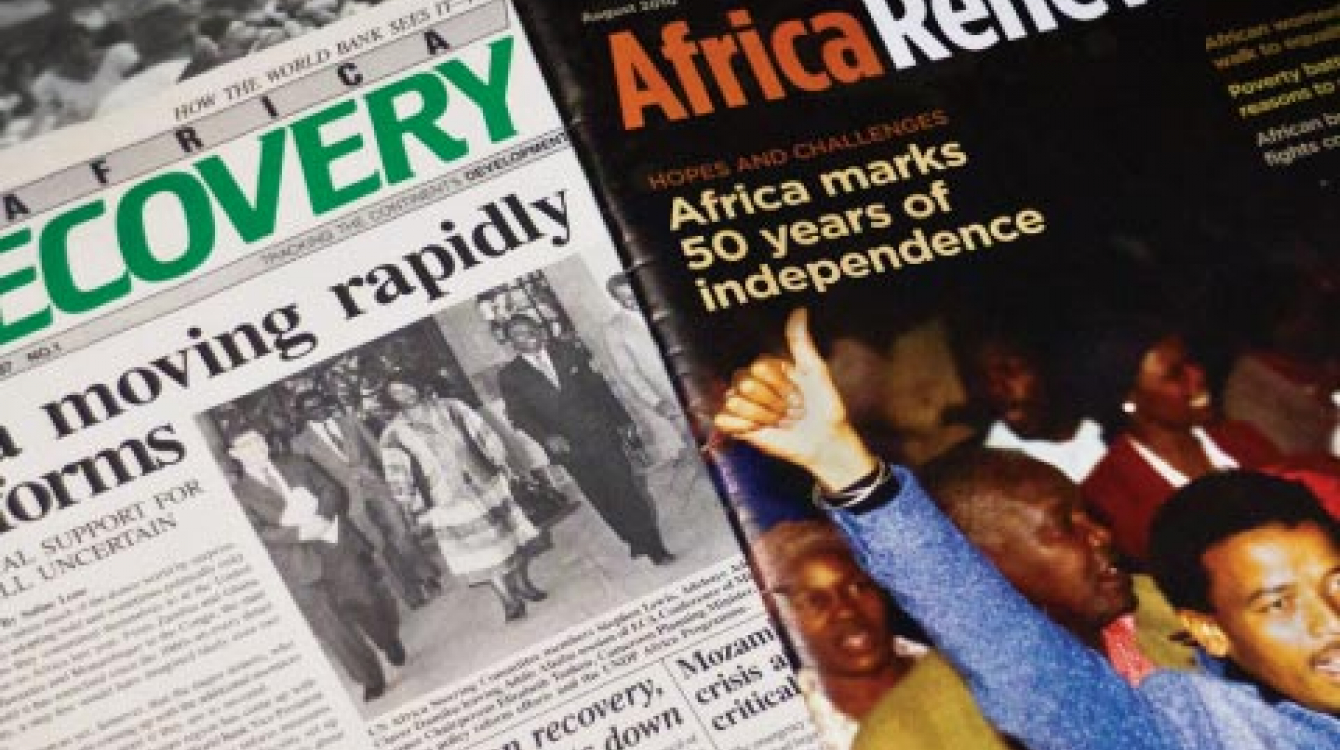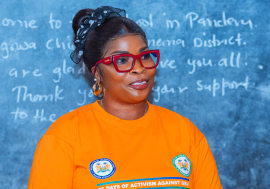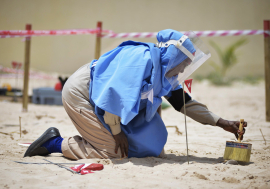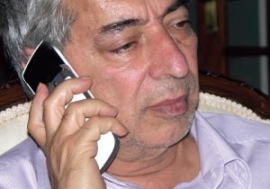Two Africa Emergency debut newsletters, neatly kept in the New York offices of the United Nations Department of Global Communications’ Africa Section, provide a snapshot of Africa in 1985. That was before the internet when many newsrooms were noisy with the clacking of typewriter keys.
The 16-page newsletter was printed in black and white, except for its name Africa Emergency on the masthead, which appeared in green. Fast-forward to 2022. Africa Renewal is a fully digital magazine published in English, French, Kiswahili, and Chinese.
There is a sombre feel to the first edition of the old newsletter, which appeared in April 1985. Two cover photos feature a total of 15 people, all with grim faces. One is of Julius Nyerere, the late Tanzanian president, whose exclusive interview was featured in the edition. The stories are mostly about drought and famine. At the time, Africa was facing a severe humanitarian crisis, and the newsletter was part of the international relief operation.
After drought began in Ethiopia and spread to 20 other African countries, the United Nations set up the Office of Emergency Operations in Africa (OEOA) to coordinate humanitarian efforts. The OEOA published the newsletter.

It was a “massive famine, the worst ever in African history,” recalls Salim Lone, who worked as an editor of Africa Emergency at the time. The OEOA’s newsletter aimed to present complicated issues in a language that anyone could understand,” he said, adding: “It gave information that people were not used to getting from the UN: easy to read, easy to understand.”
From emergency to recovery
The evolution of the publication reflects the trajectory of development on the continent. As the drought receded and it became increasingly clear that the real challenge was promoting Africa’s long-term economic and social development – its “recovery” – the UN closed the OEOA, and the General Assembly held a special session on African development.
But since the Africa Emergency newsletter had developed good links with the media, governments, non-governmental organizations, and others, many thought it would be useful to have a similar publication. As a result, Africa Recovery was launched in 1987.

An editor’s note in the first issue of Africa Recovery, in April 1987, explained the new magazine’s outlook: “Clearly, emergency is no longer the continent’s prime concern,” wrote Mr. Lone, who stayed on as editor. “The focus will now be on the continent’s recovery and development efforts.”
Africa Recovery resembled a magazine more than a newsletter, with its additional pages, a dominant feature story, and other articles on a range of topics. Its stories mainly focused on economic, social, and humanitarian issues.
Therefore, as a magazine, Africa Recovery launched in 1987 is essentially the progenitor of the current publication - Africa Renewal.
As a publication of the UN, which is composed of governments, it was challenging for Africa Recovery to handle “sensitive” political issues, such as coups and rights abuses. “It was more acceptable to deal with other things,” recalls Ernest Harsch, who first joined the magazine in 1989 and was its managing editor from 2001 until 2013.
Besides, it was fruitless to try competing with the mainstream media in chasing breaking news stories.
The magazine, however, was able to capture a good slice of the African elite audience, particularly the media, decision-makers in government, academics, civil society activists, and others.
It was “a breath of fresh air,” Mr. Harsch remembers, “and it worked well for us.” As African countries moved towards greater democracy in the 1990s, political topics became easier to cover as well.

Enter Africa Renewal
In 2004, the magazine’s name changed to its current Africa Renewal. In a message to readers, former under-secretaries-general Shashi Tharoor (Communications and Public Information) and Ibrahim Gambari (the Secretary-General’s Special Adviser on Africa) justified the new name: “Most countries [in Africa] now have democratically elected governments…. African leaders have devised a forward-looking plan, the New Partnership for Africa’s Development (NEPAD).”
They continued: “By changing its name [from Africa Recovery] to Africa Renewal, the publication seeks to identify itself more squarely with Africa’s new dynamic of initiative and rebirth.”
The magazine continued to expand its coverage of Africa’s development agenda, highlighting the work of the UN Economic Commission for Africa, NEPAD, and UN Office of the Special Adviser on Africa, among others.
The advent of the internet and mobile communications technologies made available to readers multiple sources of information.
Parvati Heather McPheeters, who created the magazine’s first website in early 1997, says: “At the time, the goal was to give access to a few more readers, by dozens, not thousands.” Ms. McPheeters, who left the magazine in 2006, adds: “I am gratified I had been part of setting up the infrastructure.”
A key aspect of Africa Renewal’s modernization was not just plugging into the information superhighway, it also was transitioning from a black and white to a colored publication and softening its content to increase its appeal.
Masimba Tafirenyika, who joined the team in 2009 as editor-in-chief and left in 2017, helped implement a modernization strategy. “It was important,” he explains, “we were not left behind in a changing world…We had been behind the time with a black-and-white publication. And young African women and men were dominating new startups in information and communications technology, agriculture, and other sectors. We needed to appeal to them. So, we changed our writing style to make it less technical and more journalistic, and we began to cover issues, such as information and communications technology and culture.” Mr. Tafirenyika is now the Director of the United Nations Information Centre in Pretoria, South Africa.
“Africa Renewal needed to go with the flow at the time,” notes Margaret Novicki, who was Chief of the Communications Campaigns Service (CCS) of the United Nations’ Department of Public Information (now Department of Global Communications or DGC) when Mr. Masimba was in charge of the magazine.
Writers, editors, and other colleagues jumped with joy in August 2010 when the first colour, semi-glossy pages were printed. “It was a milestone moment for the magazine. I was very proud of the team,” says Ms. Novicki.
Going digital
Ten years after the celebration of the magazine’s first coloured print publication, Africa Renewal became fully digital in 2020.
Africans’ increasing access to smartphones, and by extension digital content, had made a digital transition inevitable, but the outbreak of the COVID-19 pandemic in late 2019 and the subsequent disruptions to production and distribution of print copies accelerated the shift by 2020.
Follow us on social media:
- Twitter: @AfricaRenewal and @ONUAfrique
- Facebook: @AfricaRenewal and @Afrique Renouveau
Subscribe to our monthly newsletter
“As COVID-19 hit, we needed to adjust swiftly to the new reality of the communications environment. We had to devise creative means of engaging with new audiences, while retaining our reliable print readers,” says Sandra Macharia, current Editor-in-Chief.
Africa Renewal digital products now include Africa Renewal audio stories, an initial Africa Renewal Podcast series, and a monthly-curated Africa Renewal e-Newsletter.
“We tell stories of hope and showcase solutions, which is so important in these times as we face global challenges - such as climate change and equitable pandemic recovery - that also have local impact on people’s lives,” adds Ms. Macharia. “We aim to engage our audience with a narrative of Africa that inspires action towards a more sustainable, inclusive and prosperous Africa.”
“The payoff is an appeal to diverse audiences, including youth and women, in different part of Africa,” adds Zipporah Musau, who succeeded Mr. Harsch as managing editor.
Wishing Africa Renewal a Happy 35th Birthday!


